
The Custom House is a neoclassical 18th century building in Dublin, Ireland which houses the Department of Housing, Local Government and Heritage. It is located on the north bank of the River Liffey, on Custom House Quay between Butt Bridge and Talbot Memorial Bridge.

HM Customs and Excise was a department of the British Government formed in 1909 by the merger of HM Customs and HM Excise; its primary responsibility was the collection of customs duties, excise duties, and other indirect taxes.

The Hunt Museum is a museum in the city of Limerick, Ireland. The Hunt Museum holds a personal collection donated by the Hunt family, it was originally situated in the University of Limerick, before being moved to its present location in Limerick's Georgian custom house in 1997. The Custom House is situated on Rutland Street on the banks of the River Shannon at its confluence with the Abbey River. Among the museum's collection are works by notable artists and designers such as Pablo Picasso, Jack B. Yeats, and Sybil Connolly as well as distinctive historical items such as the O'Dea Mitre and Crozier.

The history of Limerick stretches back to its establishment by Vikings as a walled city on King's Island in 812, and to the granting of Limerick's city charter in 1197.
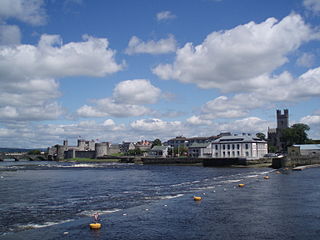
King's Island is an area of central Limerick, Ireland. The area is often referred to colloquially as The Island and consists of two distinct areas, Englishtown and St Mary's Park. The historical city of Limerick known as Englishtown is located on the southern end and St Mary's Park; a local authority housing estate is located on the northern end.

As with other cities in Ireland, Limerick has a history of great architecture. A 1574 document prepared for the Spanish ambassador attests to its wealth and fine architecture:
The architecture of Ireland is one of the most visible features in the Irish countryside – with remains from all eras since the Stone Age abounding. Ireland is famous for its ruined and intact Norman and Anglo-Irish castles, small whitewashed thatched cottages and Georgian urban buildings. What are unaccountably somewhat less famous are the still complete Palladian and Rococo country houses which can be favourably compared to anything similar in northern Europe, and the country's many Gothic and neo-Gothic cathedrals and buildings.

Customs House, Sydney is a heritage-listed museum space, visitor attraction, commercial building and performance space located in the Circular Quay area at 45 Alfred Street, in the Sydney central business district, in the City of Sydney local government area of New South Wales, Australia. The building served as a customs house prior to Federation and then as the head office of New South Wales operations of the Government of Australia agency Department of Trade and Customs (and its successors) until 1988. The customs function relocated to a new site in 1990. The initial designs were by Mortimer Lewis and it was built during 1845 by under the administration of Governor Sir George Gipps. It is also known as Customs House (former) and Site of former Customs House. The site was added to the Commonwealth Heritage List on 22 June 2004; and to the New South Wales State Heritage Register on 2 April 1999.

HM Customs was the national Customs service of England until a merger with the Department of Excise in 1909. The phrase 'HM Customs', in use since the Middle Ages, referred both to the customs dues themselves and to the office of state established for their collection, assessment and administration.

O'Connell Street is the main thoroughfare of the city of Limerick. It was previously known as George's Street until it was renamed after Daniel O'Connell. The street runs in parallel to the River Shannon and forms part of an overall thoroughfare, along with Rutland Street and Patrick Street, that bisects Limerick City Centre in a north east to south west direction. The street is about a mile in length, starting at the Arthurs Quay / Denmark Street junction and ending at The Crescent. A monument to Daniel O'Connell stands at the centre of The Crescent overlooking O'Connell Street. The street is noted for its Georgian architectural heritage.
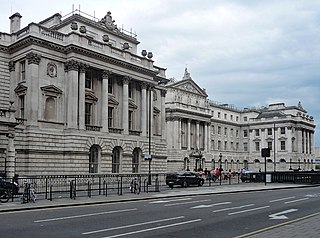
His or Her Majesty's Excise refers to 'inland' duties levied on articles at the time of their manufacture. Excise duty was first raised in England in 1643. Like HM Customs, the Excise was administered by a Board of Commissioners who were accountable to the Lords Commissioners of the Treasury. While 'HM Revenue of Excise' was a phrase used in early legislation to refer to this form of duty, the body tasked with its collection and general administration was usually known as the Excise Office.
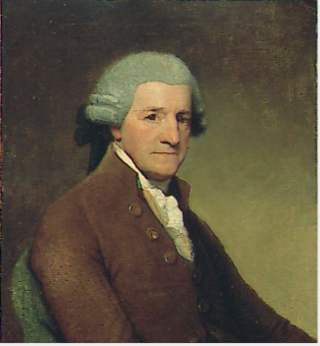
Edmund Sexton Pery, 1st Viscount Pery was an Anglo-Irish politician who served as Speaker of the Irish House of Commons between 1771 and 1785.

Limerick Museum, previously known as the Jim Kemmy Municipal Museum, is a city museum in Limerick, Ireland.

Limerick City Gallery of Art is an art museum in the city of Limerick, Ireland. It is run by Limerick City Council and is located in Pery Square, in the Newtown Pery area of the city.

Newtown Pery is an area of central Limerick, Ireland, and forms the main city centre of the city. The district is known for its Georgian architectural heritage and is the core area of Limerick's Georgian Quarter. It is one of the three towns that make up modern-day Limerick City Centre, the other two being the older Englishtown and Irishtown, which date from the medieval period. Newtown Pery houses the largest collection of Georgian townhouses in Ireland outside of Dublin. In 1837, Samuel Lewis in his Topographical Dictionary of Ireland described Newtown Pery as "one of the handsomest towns in Ireland".
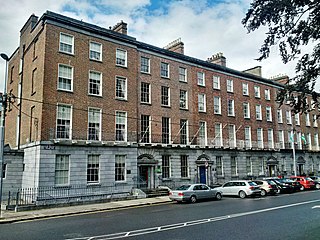
Pery Square is a Georgian Terrace located in the Newtown Pery area of Limerick city, Ireland. The terrace was constructed as a speculative development by the Pery Square Tontine Company between 1835 and 1838. The square was named in honour of the politician Edmund Sexton Pery. The terrace is notable as one of the finest examples of late Georgian architecture in Limerick and Ireland.
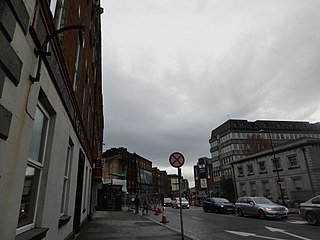
Rutland Street is a street in central Limerick, Ireland that forms part of the main central thoroughfare of the city which incorporates Rutland Street, Patrick Street and O'Connell Street. Named after the 4th Duke of Rutland, Charles Manners, who was appointed Lord Lieutenant of Ireland in 1784 and visited Limerick in 1785. Rutland Street along with nearby Bank Place features some of Limerick's earliest examples of Georgian Architecture. It was the first street developed as part of Edmund Sexton Pery's plans for Newtown Pery, and was the first part of the great Georgian expansion of Limerick south from the medieval city. In 1901, Irish nationalists suggested renaming the street to Hugh O'Neill Street.
Davis Ducart, was an architect and engineer in Ireland in the 1760s and 1770s. He designed several large buildings and engineering projects. He had associations with the canal builders of the time and the mining industry and worked on many projects in the County Tyrone coalfield.

The Custom House is an early 19th-century building in Cork, Ireland. Originally developed as a custom house and opened in 1818, the Cork Harbour Commissioners took over the building in 1904. The Port of Cork Company vacated the building in early 2021. The Custom House is, together with a number of other buildings on the same site, listed by Cork City Council on its Record of Protected Structures.

The Custom House was a large brick and limestone building located at present day Wellington Quay in Dublin, Ireland which operated as a custom house, hosting officials overseeing the functions associated with the import and export of goods into and out of Dublin from 1707 until 1791. It also served as the headquarters of the Revenue Commissioners, as a meeting place and offices for the Wide Streets Commission and was said to be Dublin's first dedicated office building.





















